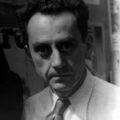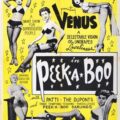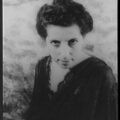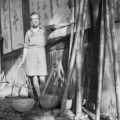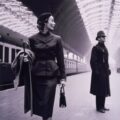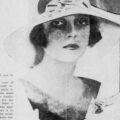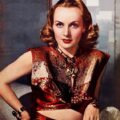Model and Photographer Lee Miller
February 6, 2019Lee Miller was a woman with a fascinating life. She was extremely beautiful, intelligent, and artistic, but also a volatile alcoholic and neglectful mother. She was a model in New York for Vogue in the 1920s before becoming a war correspondent for the magazine, taking resonant pictures such as the one of herself in Hitler’s bath, on the day that he killed himself.


Lee Miller and her Father, Theodore Miller, in 1931. Image via Pinterest.

Lee Miller (centre) by George Hoyningen-Huene. Image via Pinterest.

Cecil Beaton: Lee Miller and Marion Morehouse, 1929. Image via Pinterest.

By Man Ray, 1929. Image via Pinterest.

By George Hoyningen-Huene, 1932. Image via Another Mag.
Lee Miller – Ancestry and birthplace
Elizabeth “Lee” Miller, Lady Penrose was born on April 23, 1907 in Poughkeepsie, New York, USA. Her father, Theodore Miller had German ancestry and her mother Florence Miller (née MacDonald) was from a Scottish and Irish background. She had two brothers, John and Erik.
Lee was her father’s favourite, and he took a lot of photographs of her, both nude and clothed from when she was a child onwards. She features in his experiments with stereoscopic photography and also in tableaux with her friends, all nude as well. Though this is odd at best, there is no suggestion that her father molested her. But at the age of seven, whilst staying with a family “friend” Lee was raped and infected with gonorrhoea, the treatment for which was incredibly painful.
After that continually expelled from every school who enrolled her, because, though clever, she was so anarchic and extremely fond of pranks.
Studying Art

Lee Miller, “Untitled (Severed Breast)” 1930
She went to Paris to study art in 1925, but she stayed only a brief time because her father demanded her return. Instead, she enrolled at the Art Students League in New York to study instead. But those studies were cut short too.
The legend goes that Lee became a model at the age of 19 in 1926 after she was pulled from the path of a speeding car in New York by none other than Condé Nast, the publisher of Vogue. Gasping at her beauty he immediately added her to the roster of models for the magazine. But since she had been a photo model for her dad all these years, if he did rescue her it was no co-incidence; Lee was doubtless looking to get into the professional modelling world at that point. Although actively participating in this world and later the Surrealist artist circle which, if anything, objectified women even more, she wasn’t uncritical of the “meat market” she was involved in, later on taking a very pointed photo of a severed breast served on a dinner plate as a comment on the way women’s bodies were served for consumption.
Lee Miller – The Model of the Moment
Lee was, of course, photographed by Cecil Beaton and the usual roster of Vogue photographers, including Edward Steichen, Arnold Genthe, Nickolas Muray and George Hoyningen-Huene. She featured on the cover of the magazine in a beautiful drawing by George LePape on March 15th, 1927. Her androgynous look represented the 20th century “Modern Girl” perfectly, and she was photographed alongside that other girl of the moment, Marion Morehouse. Their physiques are very similar, although Marion is taller.
For two years Lee’s picture was everywhere. Her breasts were used as a mould for champagne glasses by a French company. One photo of her by Edward Steichen, (used without her consent since models did not have control of their own image at that time), became the first depiction of a real woman in advertising for menstrual pads. The rumour is that the scandal caused by this ended her career after such a short time, but perhaps the ever restless Lee just moved on.
Lee Miller – Parisian Sensation
In 1929 she went to Paris, and going straight to the studio of Man Ray, demanded that he take her on as a pupil. Ray told her that he didn’t teach, and anyway he was off on holiday. “That’s fine”, said Miller. “I’m coming with you”. So she did. Miller had already been taught photography by her dad, and learned about techniques on set as a model.
Man Ray was a fashion photographer and Surrealist artist using photography as his primary medium. His and Miller’s photographs became indistinguishable; it is thought that many of Lee Miller’s photographs are mis-attributed as Man Ray works. Many of photographs featuring Lee posing were conceived and authored by her, even if Ray physically pressed the shutter, and in other cases the two worked on photos together in symbiosis. The pair were lovers as well as partners in art.
Lee became part of the Surrealist circle and posed for other artists too. Meeting Jean Cocteau in Paris, she featured as an armless statue in his 1931 Surrealist film Blood of a Poet. She subsequently took portraits of many of the circle, including Max Ernst and Leonora Carrington, and the British Surrealist Eileen Agar.
Advertising Photographer
Splitting with Man Ray, Miller moved back to America and established her own photo studio with her brother Erik, taking society portraits and working on advertising images for clients like Helena Rubenstein.
In 1932 the Julian Levy Gallery included her in a group show, as did the Brooklyn Museum, and in 1933 the Julian Levy gave her her only solo show, which was well reviewed.
Travel Photographs
By 1938 she had broken with Bey and was once again travelling, this time through Athens to Bucharest with Roland Penrose, the artist who was to become her second husband. Penrose’s book of poems and photographs from the trip, “The Road is Wider than it is Long” which was dedicated to Miller, is regarded as a masterpiece of Surrealism. Lee Miller photographed the trip too. Her pictures were completely different and of a far more professional standard than her acclaimed husband’s published snapshots.
Fashion and War Photography
She began photographing for British Vogue, initially fashion shots. When world war two broke out she received press accreditation and went to the Front, producing powerful reportage photos. She photographed occupied France and the Liberation of Paris. She was the first photographer at the liberation of Dachau concentration camp and her pictures are unflinching.
It was at that point that she became a journalist too. She had started by asking to write the captions for her own photographs, and this expanded to become reportage on the situation. British Vogue didn’t print the majority of her harrowing pictures and stories, having a policy of a cheerful outlook in war. American Vogue was more willing to show its readers the reality.
Lee never found writing easy, even when it was about a less sensitive subject. But her prose was eloquent and moving. She wrote with a glass of cognac in hand. “Every word I write is as difficult as ‘tears wrung from stone’. I lose my friends and my complexion in my devotion to the rites of flagellating a typewriter,” she cabled to her editor, Edna Woolman-Chase.
Lee Miller – Cordon-Bleu Cook
Unfortunately, on returning home post war her gifts for writing and photography nearly deserted her, while the glass in her hand remained a permanent fixture. Suffering PTSD, she rarely took photographs or wrote prose again, and instead turned to the soothing art of cookery. Since Miller didn’t do things by halves, in her case it was Cordon-Bleu cookery and she wrote several cookbooks.
But though her food was exquisite, her personality wasn’t, and, now married to the artist Roland Penrose with a son called Antony her moods deteriorated as her alcoholism deepened. She remained friends with artists like Pablo Picasso and Henry Moore all her life though.
Her son recalls an unhappy childhood with a mother he barely knew, although it was he who rediscovered her archive of photographs in the attic at Farley Farm House when she died of cancer in 1977. Antony Penrose created his mother’s reputation as an artist and not just a passive model and muse writing several books about her and curating her photographs. They are now preserved in the Lee Miller archive England as well as kept in many important collections and regularly shown.




